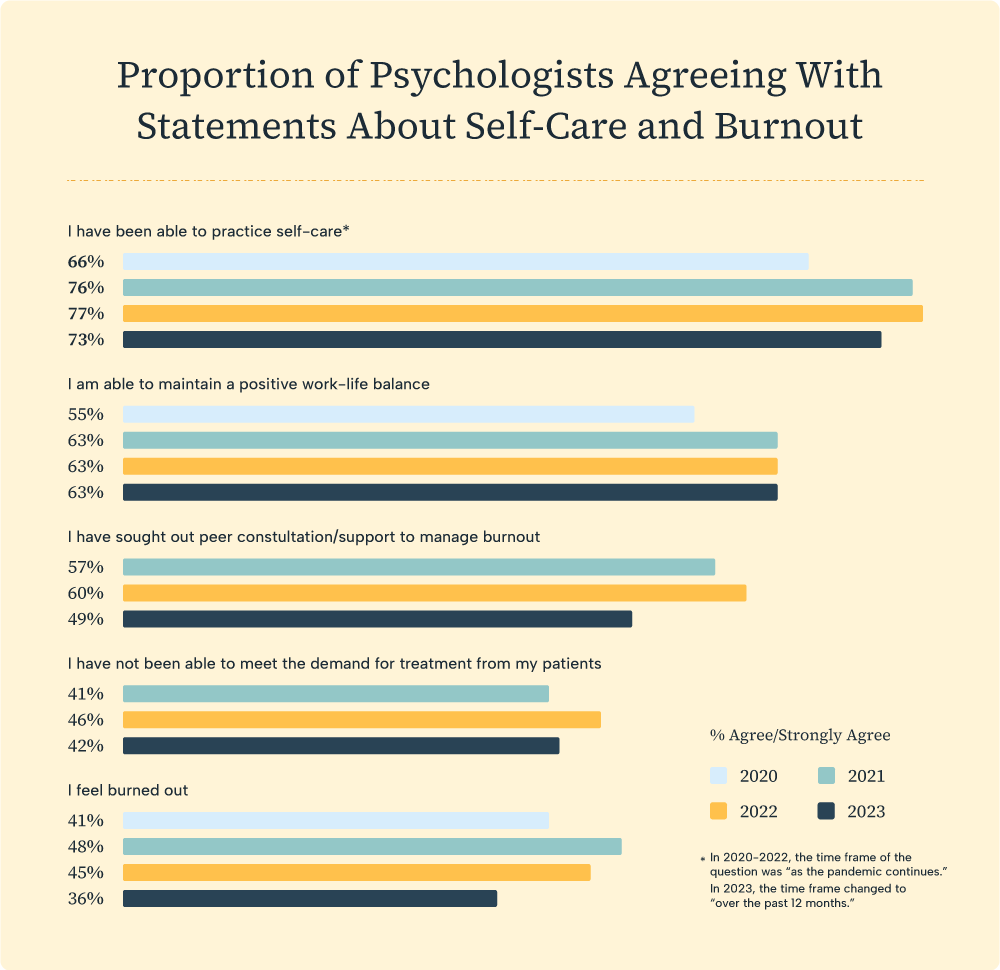Behavioral Health Burnout: Causes, Signs, and Tips to Beat It
Burnout, burnout, burnout!

Your org might not be Jan Brady, but if it feels like someone is acting the part of diva—lookin’ at you, burnout—you’re not alone. Burnout is everywhere you turn—teachers, surgeons, and creatives all report feeling burnt out at different stages of their careers. But in behavioral health, burnout isn’t just around, it’s on the rise. It has been for some time—and not just in the wake of COVID-19.
So if your org (or even you yourself) find burnout lurking around the corner, threatening to rain on your parade—and you’re seeking some burnout-busting resources—don’t worry, we’ve got your back. 💪 Below, you’ll find a one-stop resource for all things burnout. In addition to tackling each topic at a high level, we’ve provided links to more in-depth resources for each. So dig in, read on, and click around to answer every burning burnout question. 👀
What are the behavioral health burnout fast facts?
According to The National Council, “more than nine in 10 behavioral health workers (93%) said they have experienced burnout, and a majority report suffering from moderate or severe levels of burnout (62%).”
It’s easy to sit here and say that it doesn’t have to be this way. We do have evidence that burnout can be beaten—or at least reduced—through the use of technology that relieves administrative burdens. And the APA 2023 Practitioner Pulse Survey indicates that as psychologists have increased time for self-care and peer support, their levels of burnout have decreased year-over-year.

But technology—even innovative, purpose-built, clinically validated technology—isn’t a silver bullet for burnout. To beat burnout for good, you have to address the root cause of the problem—not just the symptoms.
What causes burnout in behavioral health orgs?
We’re all in agreement that burnout is prevalent across behavioral health—and all healthcare verticals, TBH—but what is actually causing the provider burnout crisis? That’s a bit of a tricky question. The burning problem with burnout is that there isn’t one single cause. When it comes to burnout, the straw is absolutely breaking the camel’s back, and the trickle-down effect is a big factor—with each cause putting additional pressure on the next.
- Lingering effects of the COVID-19 pandemic: The mental health crisis didn’t begin with the COVID-19 pandemic, but it certainly didn’t help.
- Overwhelming caseloads: Providers want to help people in need, but there is a limit on how many clients a provider can see in a day or week—and it isn’t just because of the number of work hours allowed
- Documentation burdens: On top of the sheer size of each provider’s caseload is the documentation for all of the sessions tied to those cases. If only there was a way to lift this burden from clinicians. 👀
- A lack of support from supervisors: Providers need to feel supported professionally and personally—with opportunities to grow as well as opportunities to speak up when something doesn’t feel right.
- Providers’ mental health: Clinicians are people too, and they need space to work through their own internal mental health challenges.
To learn more about the causes behind behavioral health burnout, check out our research-informed summary of the subject 👉 The Facts Behind the Fizzle
What are some downstream effects of burnout?
We’ll go over ways to spot burnout among behavioral health professionals shortly, but let’s quickly touch on some of the downstream effects of burnout that can catch fire at an org.
- High turnover: Less than 60% of addiction counselors remain in the field for five or more years, and only 29% maintain their current job for five or more years.
- Poor client experiences and outcomes: We know that when providers are burned out, care quality and client experiences suffer.
- Late progress notes: Bad notes are one thing, but late notes are a whole other issue.
- Compliance risk: When notes are late—and not up to snuff—your org runs the risk of not getting paid (or at least not getting paid enough).
- The burnout snowball effect: When providers leave their jobs due to workplace stress or burnout, the remaining providers’ increased workload leads to increased stress and burnout. And as more providers exit, clients are unable to receive the care they need—negatively impacting their care outcomes and experience. It’s the proverbial Marvel multiverse effect, but instead of Spiderman pointing at himself, it’s burnout.
What are the risks of not addressing burnout?
It might seem obvious—but we’d be remiss if we didn’t address ongoing effects (and risks) of not stamping out burnout.
- Continuous turnover: If organizational issues are fueling unaddressed burnout among staff, they will eventually leave—and once that revolving door starts swinging, it’ll be tough to stop it without first stamping out burnout.
- Difficulty recruiting: Clinicians talk—and reputations matter. Peep our workforce guide for help turning your org into a best place to work. 👀
- Client turnover: When clients can’t see the same clinician on an ongoing basis, they’re going to seek out an org where they can build that crucial long-term therapy partnership (if their personal situation allows for it).
- Revenue loss: When clients no-show due to disengagement, or stop care altogether, the lost revenue can be detrimental. Add to that revenue losses due to clawbacks from late or insufficient documentation, and the financial impact can be substantial.
Links Referenced in This Section
- The Facts Behind the Fizzle: What Science Reveals About Behavioral Health Burnout
- AI Demystified: Beating Burnout and Elevating Outcomes with BH Tech Innovation
- Beating Provider Burnout – 90% of Trilogy Staff Feel Less Stressed with Eleos
- Turning the Tide on Provider Burnout: How Behavioral Health AI Solves Major Workforce Challenges
- Why Therapists Quit: Unfiltered Stories from the Field
- Rising Above the Workforce Shortage: Building a “Best Place to Work” in Behavioral Health
Learn More About Burnout: Video Resources
- 90% of Trilogy Staff are Less Stressed with Eleos Outreach – Watch their Story
- “Eleos has been life-changing for me” – Trilogy Provider Testimonial
- “If something like this had been available when I was still a clinician, I’d still be a clinician.”
- How Eleos reduces provider burnout (customer testimonials)
What does behavioral health burnout look like?
Just like your staff members are all different, burnout looks different in each provider, supervisor, or manager. But the end result is the same: staff that don’t want to do “it” anymore—whether “it” is seeing clients back-to-back, filling out paperwork, or monitoring provider performance. Identifying when your staff is teetering on the edge is key to finding solutions before anyone makes it past the point of no return.
How do behavioral health orgs identify and address staff burnout?
While there is no burnout alert blueprint, per se, orgs can look out for the following telltale signals that something just isn’t right.
Signs of Burnout in Behavioral Health Clinicians
- Excessive pajama time: Your providers are working over-overtime—especially to complete administrative tasks—when they should be recharging their batteries.
- Disengaged clinicians: Your providers are so beleaguered by documentation, they’re struggling to maintain—or build—proper connections with their clients (especially if they’re glued to their computers during sessions).
- Disengaged clients: When concurrent documentation takes over sessions, clients are less inclined to form that vital connection with the provider, which can lead to less-than-ideal outcomes.
- Lagging documentation and poor note quality: Documentation that’s late more often than not, or notes that are lower quality than expected (think excessive use of cloning or fields that are missing key elements like treatment plans), become the norm.
- Physical symptoms: Burnout in healthcare providers doesn’t just manifest in work-specific ways, but can also cause exhaustion and fatigue, as noted by SAMHSA in 2022.
Links Referenced in This Section
- Beating Provider Burnout – 90% of Trilogy Staff Feel Less Stressed with Eleos
- The Facts Behind the Fizzle: What Science Reveals About Behavioral Health Burnout
- The Future is Now: How Purpose Built AI Reduces Staff Stress & Stops Burnout
- Less Burnout, Better Care: The Undeniable Workforce Benefits of Behavioral Health AI
Learn More About How Eleos Impacts Documentation Burnout: Video Resources
- “It’s taking me 50% to 75% less time to do my notes.” – Clinical psychologist using Eleos
- “Eleos really is game-changing.” – Clinical psychologist in community mental health
- CEO: “Our cash flow is moving at a much better rate with Eleos.”
- Mental Health Executives on their Positive Experience with Eleos (mhca Winter Conference 2024)
How can behavioral health orgs beat burnout?
Organizational culture gets thrown around a lot in any discussion about staff satisfaction:
“Build a culture of excellence.”
“Create a culture of innovation.”
“Great culture breeds great results.”
But a truly great culture is so much more than a tagline. And truly great orgs know that cultivating a culture of success means building transparency, active listening, and reflection into the company’s DNA.
That doesn’t mean burnout won’t exist—it just means you’re willing to put in the work to innovate, experiment, and iterate as you find the best ways to improve the staff experience in your specific org—and even fuel recruiting.
What are the culture must-haves for a great org?
- Develop a culture of innovative excellence: Choose to research, invest in, and advocate for technological advancements that will impact your teams.
- Seek a culture of openness and transparency: Don’t just assume your team members are hearing you, or that you’re hearing them. Open channels of communication and encourage folks to speak up.
- Foster a real culture of continuous learning: “Continuous learning” is almost as overused as “culture of excellence.” But if your agency works to learn from every major project, every win, and every snafu—it goes from buzzword status to key pillar of staff engagement.
How do orgs prevent (or turn the tide on) burnout?
We’re glad you asked. First, check out our blog post answering that exact question. Now, here’s a quick summary:
- Listen to your teams and prioritize psychological safety: Beyond just offering transparency and openness, giving teams the ability to tell leadership how they really feel allows them to feel not only heard, but also seen.
- Lift burdens that are the bane of your providers’ existence: If you know something is bringing your team down, work to fix it. Not every burden can be lifted with technology, but many can—and staff morale notably improves when they see you making the effort.
- Focus on other measures of productivity: In healthcare, productivity is often measured in billable services—which makes sense, since it is how agencies keep their doors open. But for providers, “increasing productivity requirements” sounds a lot like “adding to already-overwhelming caseloads.” That’s why orgs should look to other measures of productivity—such as better client outcomes or increases in client satisfaction, engagement, and touches—to help keep burnout at bay.
- Provide training and career development: It’s common sense, right? Entry-level providers don’t want to stay entry-level forever. But real-time supervisory input and growth metrics aren’t always easy to implement. Technology can help—even just to show your staff that you care about their future, not just their present.
Content Referenced in This Section
- Rising Above the Workforce Shortage: Building a “Best Place to Work” in Behavioral Health
- Culture Clash: 5 Ways to Ruin Your Behavioral Health Work Environment
- Turning the Tide on Provider Burnout: How Behavioral Health AI Solves Major Workforce Challenges
- Reducing burnout among mental health workers: How community behavioral health clinics support their clinician teams
- The Future is Now: How Purpose Built AI Reduces Staff Stress & Stops Burnout
- Less Burnout, Better Care: The Undeniable Workforce Benefits of Behavioral Health AI
- The Productivity Predicament: 6 Alternative Approaches to Performance Management in Behavioral Health
- Why Career Pathing is the Key to Staff Loyalty in Behavioral Health
- The Essential Guide to Employee Benefits in Behavioral Health: 2024 Edition
Learn More: Video Resources on Company Culture
- CEO: “Our staff are less frustrated with paperwork now that they have Eleos.”
- CEO: “Eleos makes me worry less about paybacks.”
- How Eleos improves staff performance (customer testimonials)
- How Eleos boosts hiring and retention in behavioral health (customer testimonials)
What is the future of burnout in behavioral health?
Burnout won’t ever magically disappear. There are just too many external forces at play—the workforce shortage, the ever-growing mental health crisis, and increasing financial strain, to name a few. And none of those can be solved overnight, even with the most sophisticated technology.
But, we can all work together to achieve a brighter behavioral health future through the incomparable combination of culture + technology.
Ready to talk to an expert about how Eleos can help alleviate provider burnout at your org? Book time with us today!
Full list of linked burnout resources, by title:
- AI Demystified: Beating Burnout and Elevating Outcomes with BH Tech Innovation
- Beating Provider Burnout – 90% of Trilogy Staff Feel Less Stressed with Eleos
- Better Care, Stronger Data: Where Payers and Providers Converge on AI
- Culture Clash: 5 Ways to Ruin Your Behavioral Health Work Environment
- Less Burnout, Better Care: The Undeniable Workforce Benefits of Behavioral Health AI
- Reducing burnout among mental health workers: How community behavioral health clinics support their clinician teams
- Rising Above the Workforce Shortage: Building a “Best Place to Work” in Behavioral Health
- The Essential Guide to Employee Benefits in Behavioral Health: 2024 Edition
- The Facts Behind the Fizzle: What Science Reveals About Behavioral Health Burnout
- The Future is Now: How Purpose Built AI Reduces Staff Stress & Stops Burnout
- The Productivity Predicament: 6 Alternative Approaches to Performance Management in Behavioral Health
- Turning the Tide on Provider Burnout: How Behavioral Health AI Solves Major Workforce Challenges
- Why Career Pathing is the Key to Staff Loyalty in Behavioral Health
- Why Therapists Quit: Unfiltered Stories from the Field

